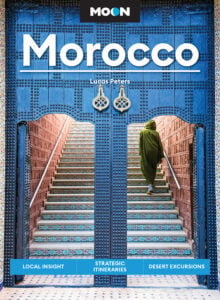 Over the centuries, Marrakesh has been a desert oasis, military headquarters, a religious center and the playground of a sultan. It is one of Morocco’s great cities, but it began as a watering hole for the local Berber tribes. It was little more than a remote outpost before the Almoravid Berber leader Youssef bin Tashufin, cousin to the sultan, and his wife Zeinab founded what would become the city of Marrakesh in 1062 A.D.
Over the centuries, Marrakesh has been a desert oasis, military headquarters, a religious center and the playground of a sultan. It is one of Morocco’s great cities, but it began as a watering hole for the local Berber tribes. It was little more than a remote outpost before the Almoravid Berber leader Youssef bin Tashufin, cousin to the sultan, and his wife Zeinab founded what would become the city of Marrakesh in 1062 A.D.
Under Tashufin’s guidance, the city grew house by house. A mosque was established and, eventually, Marrakesh became the capital of the Almoravid Empire. Under the Almohads, Marrakesh developed into a luxurious Islamic city. It quickly became a center of commercial power.
Originally captured by the Almohads in 1147 A.D., the existing religious and civic structures were destroyed; it was stripped down to little more than plumbing. Marrakesh is known as the “red town” because of the distinctive Kasbah wall that surrounds the city’s medina. Yacoub el-Mansour redesigned the city and incorporated a fortified Kasbahs, beautiful gardens, covered markets called gissariats and the Koutubia mosque, the city’s major landmark.
Yet, the Almorvid Empire lost Marrakesh to the Merenids in the middle of the 13th century. A period of steep decline followed as the city lost its prominent place in the region to Fez. Marrakesh was largely neglected during the reign of the Merenids. Nearly 300 years later, the Saadians took control of Morocco in 1522. By this time Marrakesh was in ruins, but Sultan Moulay Abdullah established it as a new capital for the Saadian kingdom in 1551. A rich sugar trade funded new construction, and Mohammed Al Mahdi set about restoring the grandeur of Marrakesh.
During this period, magnificent structures like the Al Bedi Palace were built. It was also a remarkable period for Moroccan craftsmanship. Many artisans traveled to Marrakesh to contribute their considerable talents to various public and private projects. By the 17th century, Marrakesh had regained its wealth and cultural influence. In 1669, it was truly the most influential city in Morocco. However, the same year spelled the end (again) of Marrakesh’s exalted status.
Almost another century of disrepair and neglect passed before Mohammed III restored the city in the middle of the 18th century. The rejuvenated city remained largely the same until 1917 when the French invaded Morocco and removed El Hiba, a Saharan chieftain who had held Marrakesh for the last five years. At that time, Morocco became a French protectorate, and a modern, French-styled city was constructed beyond the walls of the older medina.
When Morocco became independent in 1956, the new monarchy ousted the Glaousa family, but since then, the city has become a haven for artists and activity. Now, more than fifty years later, Marrakesh remains an important city with a rich cultural history that attracts visitors from around the world.
Written by Shaun Kilgore.
Photo by nigel@hornchurch.









Dear Journey Beyond Travel,
We are planning on visiting Marakech in mid-june and we would like to know that, if we already have accomodations, do you organize overnight tours in the desert? Or a tour around the town,its whereabouts and other family day tours?
Thank you,
Johanna
Very informative blog about Marrakech